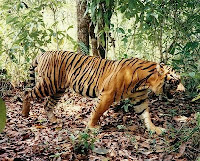
Conservation status Endangered
Genus Bubalus Species B. quarlesi, B. depressicornis
Binomial name : Bubalus quarlesi(Ouwens, 1910)
Anoa are a subgenus of buffalo comprising two species native to Indonesia: the Mountain Anoa (Bubalus quarlesi) and the Lowland Anoa (Bubalus depressicornis). Both live in undisturbed forest, and are essentially miniature Water Buffalo, are similar in appearance to a deer, weighing 150–300 kg (330–660 lb. Lives in deep rain forests.
Both are found on the island of Sulawesi in Indonesia; the Mountain Anoa is also found on the nearby island of Butung. They apparently live singly or in pairs, rather than herds, except when the cows are about to give birth. One young is born per year.
Both species of anoa have been classified as endangered since the 1960s and the population continues to decrease. It is believed unlikely that there are more than 5000 animals of each species remaining. Reasons for the decline of the anoa include hunting for hide, horns and meat by the local peoples (though they were rarely hunted in their native range before the introduction of modern firearms); and loss of habitat due to the advancement of settlement. Currently, hunting is the more serious factor in most areas.
Mountain Anoa are also known as Anoa de Montana, Anoa de Quarle, Anoa des Montagnes, Anoa Pegunungan, and Quarle's Anoa. Lowland Anoa are also known as Anoa de Ilanura or Anoa des Plaines. They are also called sapiutan (or sapi utan).
Lowland Anoa stand but little over a yard at the shoulder, and is the most diminutive of all wild cattle. It is most closely allied to the larger Asiatic buffaloes, showing the same reversal of the direction of the hair on the back. The horns are peculiar for their upright direction and comparative straightness, although they have the same triangular section as in other buffaloes.
White spots are sometimes present below the eyes, and there may be white markings on the legs and back; and the absence or presence of these white markings may be indicative of distinct races. The horns of the cows are very small. The nearest allies of the anoa appear to be certain extinct buffaloes, of which the remains are found in the Siwalik Hills of northern India. In habits the animal appears to resemble the Indian buffalo.
References
This article incorporates text from the Encyclopædia Britannica Eleventh Edition, a publication now in the public domain.
From Wikipedia, the free encyclopedia
Genus Bubalus Species B. quarlesi, B. depressicornis
Binomial name : Bubalus quarlesi(Ouwens, 1910)
Anoa are a subgenus of buffalo comprising two species native to Indonesia: the Mountain Anoa (Bubalus quarlesi) and the Lowland Anoa (Bubalus depressicornis). Both live in undisturbed forest, and are essentially miniature Water Buffalo, are similar in appearance to a deer, weighing 150–300 kg (330–660 lb. Lives in deep rain forests.
Both are found on the island of Sulawesi in Indonesia; the Mountain Anoa is also found on the nearby island of Butung. They apparently live singly or in pairs, rather than herds, except when the cows are about to give birth. One young is born per year.
Both species of anoa have been classified as endangered since the 1960s and the population continues to decrease. It is believed unlikely that there are more than 5000 animals of each species remaining. Reasons for the decline of the anoa include hunting for hide, horns and meat by the local peoples (though they were rarely hunted in their native range before the introduction of modern firearms); and loss of habitat due to the advancement of settlement. Currently, hunting is the more serious factor in most areas.
Mountain Anoa are also known as Anoa de Montana, Anoa de Quarle, Anoa des Montagnes, Anoa Pegunungan, and Quarle's Anoa. Lowland Anoa are also known as Anoa de Ilanura or Anoa des Plaines. They are also called sapiutan (or sapi utan).
Lowland Anoa stand but little over a yard at the shoulder, and is the most diminutive of all wild cattle. It is most closely allied to the larger Asiatic buffaloes, showing the same reversal of the direction of the hair on the back. The horns are peculiar for their upright direction and comparative straightness, although they have the same triangular section as in other buffaloes.
White spots are sometimes present below the eyes, and there may be white markings on the legs and back; and the absence or presence of these white markings may be indicative of distinct races. The horns of the cows are very small. The nearest allies of the anoa appear to be certain extinct buffaloes, of which the remains are found in the Siwalik Hills of northern India. In habits the animal appears to resemble the Indian buffalo.
References
This article incorporates text from the Encyclopædia Britannica Eleventh Edition, a publication now in the public domain.
From Wikipedia, the free encyclopedia










